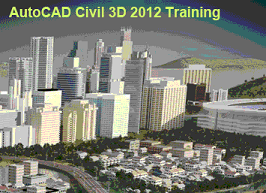
Our AutoCAD Civil 3D 2012 Training consists of more than 15 hours of video based lessons. This training dvd will show you how to use the application for civil engineering design and documentation. Used primarily by civil engineers, this program helps project teams deliver higher-quality transportation, land development, and environmental projects faster. Our training will help you learn to work more efficiently as you design ideas and analyze what-if scenarios to help optimize performance as your projects are built. Our Civil 3D 2012 Training will help you become more productive as you learn basic and advanced topics, including how to create, edit and modify Civil 3D design objects, add annotation, obtain information, import/export and use Civil 3D data in other applications, while helping you to deliver more innovative design solutions.
Course Content Description of AutoCAD Civil 3D 2012 Tutorials
Getting Started With Civil 3D
Introduction to Civil 3D
Overview
The User Interface Workspaces
Overview of The User Interface
Ribbon
Using the Toolspace
Prospector
Settings
Using the Help System
Managing Drawings
Understanding Objects
Drawing Settings
Understanding Object Styles
Switching and Deleting
Copying Styles Between Drawings
Working with Label Styles - Basic Concepts
Using Label Styles
Working with Label Sets and Modifying Labels
Working with the Annotative Properties of Labels
Getting Information about Objects
Working with Drawing Templates
Working with the Lines and Curves Commands
Survey
Working with the Survey Tools - Overview
Survey Databases
Creating a Figure Prefix Database
Setting up Linework Code Sets
Importing Point Files and Fieldbooks
Editing Figures
Working with Points
Working with Points - Key Concepts
Working with Point Settings
Creating Points in a Drawing
Description Key Sets
Importing Points
Displaying Imported Points
Creating Point Groups
Using Point Groups
Working with Point Styles
Editing Points
Creating Point Tables
Surfaces
Working with Surfaces - Overview
Creating Surfaces
Adding Breaklines to Surfaces
Adding Boundaries to Surfaces
Editing Surfaces
Working with Surface Operations
Pasting Surfaces
Performing a Slope Analysis
Working with Surface Styles
Using Surface Utilities
Labeling SurfacesContours
Labeling Surfaces Slope and Spot Elevations
Calculating Surface Volumes
Working with Alignments
Working with Alignments - Overview
Understanding Sites
Creating Alignments from Objects
Creating Alignments with the Layout Tools
Editing Alignments
Creating Offset Alignments and Widenings
Adjusting Alignment Stations
Working with Alignment Design Criteria
Adding Superelevations
Working with Alignment Labels - General Concepts
Working with Alignment Labels - Adding Additional Labels
Working with Alignment Labels - Tags and Tables
Adding Points to an Alignment
Working with Profiles
Working with Profiles - Overview
Working with Profile Views
Creating Existing Ground Profiles
Creating a Proposed Ground Profile
Editing Profiles
Using Profile Design Criteria
Labeling Profiles
Working with Profile Tools
Working with Assemblies and Subassemblies
Working with Assemblies - Overview
Working with Subassemblies - Overview
Creating Assemblies
Editing Assemblies
Creating Subassemblies from Polylines
Managing Assemblies and Subassemblies
Corridors, Intersections and Roundabouts
Working with Corridors - Overview
Creating a Simple Corridor
Adding a Baseline to a Corridor
Adding a Region to a Corridor Baseline
Working with Intersections - Overview
Creating an Intersection
Finishing the Corridor
Creating a Surface from a Corridor
Viewing and Editing Corridor Sections
Preparing to Create a Cul-de-Sac
Finishing the Cul-de-Sac
Creating a Roundabout
Sections, QTO and Mass Haul Diagrams
Working with Sections - Overview
Creating Sample Lines
Creating Section Views
Producing Sheets of Section Views
Creating Earthwork Quantity Reports
Generating a Materials Quantity Report
Working with Mass Haul Diagrams - Overview
Creating a Mass Haul Diagram
Quantity Takeoff and Pay Item Overview
Assigning Pay Items and Generating a Report
Plan Production
Working with the Plan Production Tools - Overview
Creating View Frames
Creating Plan Production Sheets
Working with Parcels
Working with Parcels - Overview
Understanding Parcel Styles
Creating Parcels from Objects
Creating Right-of-Way Parcels
Working with the Parcel Creation Tools
Editing Parcels
Renumbering Parcels
Labeling Parcel Areas
Labeling Parcel Segments
Creating Parcel Tables
Creating Parcel Reports
Grading
Working with the Grading Tools - Overview
Working with Feature Lines - Overview
Creating Feature Lines from Objects
Creating Feature Lines from Corridors
Creating Feature Lines from Alignments
Creating Feature Lines
Editing Feature Lines
Working with the Grading Creation Tools - Creating a Building Pad
Working with the Grading Creation Tools - Creating a Detention Pond
Calculating the Detention Volume of a Pond
Grading a Parking Lot
Creating a Final Finished Ground Surface
Pipes
Working with Pipe Networks - Overview
Working with Pipe Network Styles and Settings
Creating Pipe and Structure Rules
Creating a Parts List
Creating a Pipe Network Using Objects
Creating a Pipe Network Using the Creation Tools
Adding Pipes to a Network
Editing a Pipe Network
Splitting and Merging Pipe Networks
Creating Pipe Network Profiles
Modifying Pipe Profiles
Labeling Pipe Networks
Checking Pipe Interferences
Hydraflow
Working with Hydraflow - Overview
Using Hydraflow Express for Culverts
Using Hydraflow Express for Channels
Using Hydraflow Express for Inlets
Using Hydraflow Express for Hydrology
Using Hydraflow Hydrographs for Watershed Analysis
Using Hydraflow Hydrographs for Detention Pond Design
Using Hydraflow Storm Sewers - Overview
Using Hydraflow Storm Sewers for Storm Sewer Analysis
Exporting Pipe Networks to Hydraflow Storm Sewers
Importing Pipe Networks from Hydraflow Storm Sewers
Exchanging Data with Other Applications
Importing Data from Land Desktop
Working with LandXML Data
Exporting Civil 3D Data to AutoCAD
Using eTransmit
Sharing Data within Civil 3D
Sharing Data Within Civil 3D - Overview
Creating Data Shortcuts
Using Data Shortcuts
Labeling Through an Xref
Rendering
Adding Rendering Materials to Corridors
Adding Rendering Materials toSurfaces
Adding Multiview Blocks
Creating an Animation
Point Clouds
Working with Point Clouds - Overview
Creating Point Clouds
Displaying Point Clouds
Creating a Surface from a Point Cloud
|












